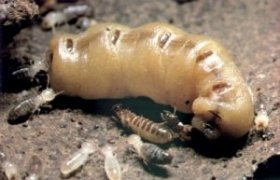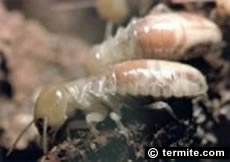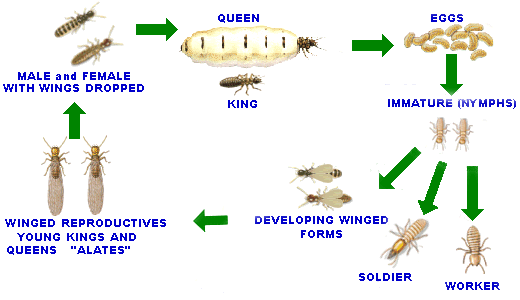Area of distribution: Western subterranean termites are a serious problem to home-owners in British Columbia,
Washington State, Oregon, Idaho, California, western Nevada and western
Mexico.
High risk areas: Western subterranean termites are in plague proportions in central and southern parts of California,
particularly in the older urban areas of the San Francisco Bay Area, Sacramento,
Reno, Fresno, Los Angeles, Orange County, San Fernando Valley and San Diego.
Contents of this page: learn about this destructive species of termite - receive tips on identification
of the timber damage caused - find out when it is likely you'll see Western subterranean termites swarm in your
local area and how to identify the swarmers, workers and soldiers - learn
of their fascinating biology, life-cycle and behavioural aspects - and receive
professional tips on how best protect your home from the world's best timber
recycler .... the subterranean termite.
BEWARE: The standard Home Insurance policy does NOT cover termite damage to structural or decoration timbers. The cost of repairs can be very expensive, particularly if you are required to remove and replace load-bearing structural timbers in the roof, wall or floor areas.
Proper identification is essential in designing an effective termite eradication and on-going protection strategy. Various species of termites encountered have different nesting locations and varying capacity to damage different timbers within a building. This is why it is important to select a professional termite controller that is skilled through tertiary training and years of practical experience in a wide variety of circumstances. Each property is different. |
Social interdependence: Within a termite colony there are members of different castes, each with
a different role to perform and all interdependent upon each other for the survival
of the termite colony. The different castes include the queen, king, the winged reproductive (young
kings and queens), soldier and worker termites.
Flying Termites? Yes, during the warmer months you may see the flying alates (winged reproductives) caste take to the air and swarm in their thousands, in order to met up with swarmers of other nests in the area so they can establish new termite colonies in the local area. This is a sure DANGER sign that a large mature termite nest is close-by. Such a nest may contain hundreds of thousands of Western subterranean termites within range of infesting the timbers in your home.
If you see swarming termites near or inside your home, we strongly recommend you immediately get your home checked out by a professional.
Termite.com has a page dedicated to Consumer Advice on selecting a professional pest control company.
|
 King, queen & worker termites
King, queen & worker termites. |
 Workers have a thin external skin
Workers have a thin external skin |
|
QUEEN: The queen termite is an egg laying machine; her body is enormous compared
to her off-spring; she can live more than 25 years and produce more that
2,000 eggs a day.
KING: The king and queen live in a central chamber and are tended by the workers.
The king and queen live in a central chamber and are tended by the workers.
|
|
WORKERS: The workers are by far the largest caste in
the western subterranean termite colony and the one that does the damage;
they are a creamy translucent colour, soft bodied and carry out all work
in the nest, including gathering food (timber and other cellulose); constructing
tunnels; repairing and enlarging the colony nest; grooming each other and
feeding the soldiers, the king, queen and also caring for the young nymphs
until mature.
Identification tips re the Western subterranean - worker termite: Western subterranean worker termites are small in size,
about half the size of match-head or 1/8" long and are soft bodied insects.
They have no wings, are sterile, blind and work 24 hours a day for their
entire 2 year life span. |
|
SOLDIERS: Western subterranean soldier termites are the defenders of the colony,
particularly against marauding ants - with whom they have engaged in a relentless
war lasting 250 million years.
Identification tips re Western subterranean termite - soldier caste: the Westrern Subterranean soldier termite s have an orange coloured rectangular armoured
head with mandibulate pinchers which they use to crush member of the ant family - their arc enemy in the insect world. The Western subterranean termite soldier has a fontanelle (frontal gland pore or hole) on their forehead used to squirk a white sticky latex,
mainly as a defense mechanism against ants.
The soldier termite is usually the first to be seen in large numbers when
any active termite workings (mud shelter tubes or damaged timber) are opened.
Soldier termites will rush out to guard the opening whilst worker termites
repair the breach. |
|
Termite Alate swarmers (or reproductives) are are commonly seen when they swarm during daylight;
they have eyes; are poor fliers but are swept along by the wind; they land,
drop their wings, find a mate to become king and queen of a new termite
colony.
Identification tips re Western subterranean termite - Alate caste: The western subteranean termite swarmers are about 3/8"
long (including wings) with a dark brown body and a small fontanelle (frontal
gland pore) on its head. Their wings are brownish grey with two dark solid
veins along the forefront of the front wings. The front wing is distinctly
larger than hind wing.
When do they swarm? In the northern part of their range, swarming takes
place in the spring, but without rain. In the southern areas, swarming usually
follows rain. The swarmers are emitted in their thousands when a mature
termite nest is large and well established.
Why do they swarm? Western subterranean termites swarm in large numbers over a wide area to
find a mate from another colony nest to start up a new colony. A suitable
location for nesting should provide moisture and a readily available timber
food source close by.
Colony nest development is slow in the first few months, with the egg-laying
capacity of the new queen termite peaking after a few years.The swarmers
are emitted in their thousands when a mature termite nest is large and well
established. Swarmers are usually produced after this period and are an
indication a large termite nest is in the vicinity, a sure danger sign and
a warning that professional protection is required.
The colony nests of Western subterranean termites are usually located in
the ground below the frost line, but above the water table. Mud galleries
or "shelter tubes" are constructed across hard objects in order
to gain access to timber food sources.
Western subterranean termites constantly search for new food sources. They
are known to enter buildings through cracks in concrete flooring or to travel
under parquetry or tile flooring through gaps of less than 1/16" wide.
Where moisture regularly collects inside the wall or other cavities of a
building, say from faulty plumbing or broken roof tiles, the Western subterranean
termite can develop a subsidiary colony nest which may not require contact
with the ground to ensure it's survival.
They build a central colony nest from which they construct underground tunnels
that radiate within a 100 yard radius from a central colony nest in search
of a timber (cellulose) food source. |
|
The picture on the left shows a termite inspector examining an above ground
termite subsidiary nest built inside a wall cavity of a home.
Termites often
build such nests if moisture is allowed to regularly collects inside the
wall cavity, say from leaking pipes, shower recess, faulty plumbing, guttering,
broken roof tiles, etc.
Termites travel in humidified mud-shelter tubes or galleries... the picture on your left shows a mud shelter "gallery" tube that Westrern subterranean termites
have constructed over a solid object, in this case, a brick foundation wall
in the sub-floor of a cottage.
Western subterranean termites travel in these mud shelter tubes as protection from
predators, sun-burn, dehydration and to maintain a high humidity environment
which is essential for their survival.
Western subterranean termites are highly secretive, preferring to enter
a building through areas inaccessible to inspection, such as, through in-fill
patios, fire heaths, expansion joints and cracks in concrete slab (on-ground)
flooring.
Western subterranean termites can pass through a 1/8" crack or an expansion
joint (eating through the rubber compound) between adjoining concrete on
ground flooring. WQestern subterranean termites can also travel under timber parquetry and other floor tiles to
get to the wall framing timbers in a building. |
Western subterranean termites have a well ordered social system with amazing
engineering capabilities and an acute survival instinct; they obtain moisture
from the soil and moist decaying timber, and communicate using pheromone
signals.
The mutual feeding, constant grooming and close social habits of termites
are used to advantage in modern termite control baiting systems. |
|
| Certain hi-tech termite baits are now on the market that have a delayed
lethal effect on termites which readily pass on the bait to other termites
in the central colony nest during the mutual grooming and feeding. |
|
Western subterranean termites need to maintain a high level of humidity
and temperature (75 to 95F) in their central colony nest.
Western subterranean termites eat through the centre of susceptible timbers
leaving nothing but a thin veneer of timber and/or paint. They will pack
mud in cracks and joints in timber to prevent loss of humidity and resultant
dehydration.
As noted above, termites constantly groom and feed each other. A valuable
technique for the termite controller is to instal and monitor a termite
baiting system next to any live activity found in and around the premises
where termite foraging is most likely to occur. Subsequent inspections (preferably
monthly) may reveal dead or sick worker termites, they change colour to
a mottle look, and spread of the termite bait to other termites leading
to elimination of the colony.
The termite baits are designed to be non-repellant to the termites and has
a unique delayed effect. Time enough to be passed onto the other termites
in the colony including the queen, with a sufficient dosage leading to the
elimination of the entire colony. This process is explained in detail in
the Termite Control section of this website. |
|
|
Comparison & Key Identification Aspects:
Subterranean Termites vs Drywood Termites
IDENTIFICATION by DIFFERENT BODY PARTS
Picture A & B illustrates that Western subterranean termites do not have cross veins in alate
wings (see pic A) whereas Drywood termites do have cross veins present on the wings of their alate swarmers (see pic B). This is a key identification point if you find the swarmers in or around your home.
Picture C & D shows that Western subterranean termites have a kneck or "pronotum" less than the width of their head for each caste (see picture
C)
whereas the Drywood termite has a pronotum as wide if not
wider than the head of each caste (as per picture D).
Picture E & F that the Western subterranean termite do not have saw-like teeth on mandibles of it's soldier caste (pic E)
whereas the Drywood termite has
saw-like teeth present on
it's left mandible in the soldier caste (pic F). Note: you often first see the soldiers when you break open infested timbers - the soldiers will rush out to defend the workers from any intriders. |
|
|
|
INDENTIFICATION by EVIDENCE THEY LEAVE BEHIND
Picture G & I: Western subterranean termites often disclose they are present in a building by evidence of their humidified mud galleries or tubes on an outside wall close to the ground (see pic G & I). Western subterranean termites travel through such mud tubes in the open environment as a means to ptotect themselves from ants and other predators.
Picture H: Drywood termites tend to leave a pile of frass ie saw dust like material and exit holes in wall elements inside or outside the building (pic H).
Picture J: shows a close-up
of six-sided frass pellets of Drywood termites.
Picture K: Western subterranean termites cause damage to timbers across the wood grain as depicted in picture
K
Picture L: whereas the Drywood termites cause damage to timbers directly along the wood grain. The evidence of timber damage is most often used in the identification of a termites species in a severely damaged building. |
|










